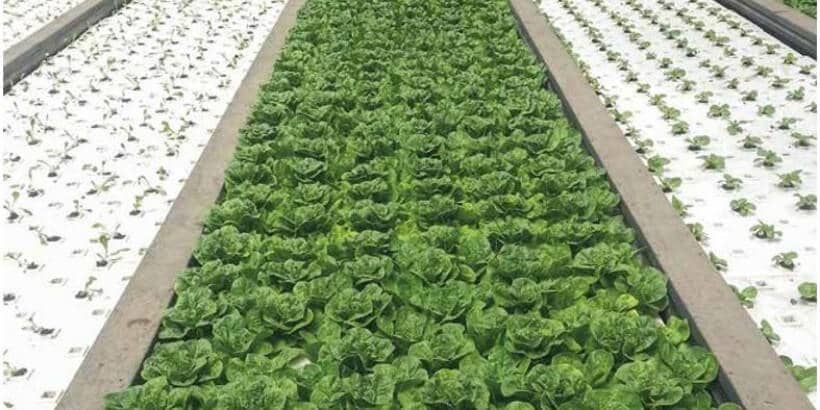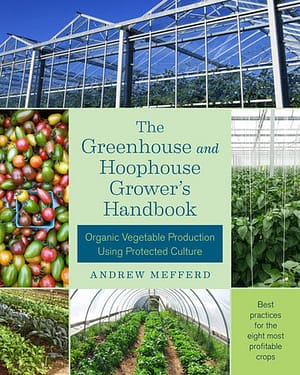Hydroponic Versus Soil Growing: Which Should You Choose

You probably learned when you were young that plants need soil to get the essential nutrients needed to grow. However, there is another way you can give your plants what they need to flourish. A hydroponic system uses water-based fertilizer as opposed to soil fertilizer. This practice is relatively new to farmers, though it is a widely used practice in greenhouses across the United States.
The following is an excerpt from The Greenhouse and Hoophouse Grower’s Handbook by Andrew Mefford. It has been adapted for the web.
(Photographs courtesy of Andrew Mefford unless otherwise noted.)
There are big differences between growing in the soil and in hydroponics, but either method can yield excellent results when managed properly. When many people use the term high-tech they mean hydroponic, but this is not always the case. I have seen some very high-tech greenhouses that are growing in soil. They can achieve yields comparable with high-tech hydroponic operations. As long as fertility is optimized, it doesn’t matter what the medium is. This may be a more common concept in Europe, where there are more organic soil-based greenhouse operations, since growers can’t be hydroponic and certified organic there.
There are advantages to growing hydroponically, which include being able to grow anywhere regardless of whether there is good soil, or any soil at all for that matter. Most of the largest greenhouses, as well as many small growers, use hydroponics for the same reason they put a greenhouse up in the first place: control. It’s much easier to assess and monitor the fertility of a hydroponic crop, since you start with a blank slate with a hydroponic medium. You know what’s available to the plant because you’re giving it all of its nutrients. In soil growing, it’s more difficult to assess nutrient availability, even if you know what’s in the soil. Root diseases are also easier to deal with in hydroponics; given that blank slate, there’s usually no disease carryover from the previous crop.
The advantages of hydroponics become apparent when contrasted with the difficulties posed by growing in the same soil year after year. Pests, diseases, fertility imbalances, and salts can build up in the soil over time.
Hydroponics allows you to start fresh every year, with clean growing medium and nutrient solution.

This young tomato crop is being grown hydroponically in a container designed for growing, called a Bato bucket.
As a soil grower, I’ve heard time and again from hydroponic growers and consultants that “sooner or later, you’re going to get disease in there,” which is probably true. It’s almost inevitable that diseases will build up over time when you grow the same crop in the same soil every year. Crop rotations help. Movable structures help, though this is only an option for smaller hoophouses without a lot of infrastructure. Grafting helps. But realistically, there is a reason why protected culture is not famous for having great crop rotations.
Unlike field growers, who grow five or more families of crops that they can rotate through different parts of the field, greenhouse growers often grow only a few families of crops, based on what is most profitable. If tomatoes are the most profitable crop, many growers are unlikely to plant another crop just for the sake of rotation, especially if they only have one greenhouse or hoophouse. The other disadvantage that greenhouse growers face when it comes to crop rotations is that it’s usually economically unfeasible to leave a greenhouse fallow for part or all of the growing season. Because field space is less expensive, many growers can afford to plant a cover crop on part of their field acreage every year to give it a rest from production. This isn’t usually possible in a greenhouse; the cost of the space demands that it be planted with a cash crop every year.
The cost of growing something less valuable than the eight crops in this book is such that most growers can’t afford to give up the revenue from their best crops. They likely can’t weather a switch from growing tomatoes to growing carrots for a year in order to get out of the crop families that they normally grow. So instead of rotating the crop, hydroponics rotates the growing medium by tossing it out and starting with new medium every year.
Types of Hydroponic Systems
Between commercially manufactured and homemade systems, there are infinite ways to set up hydroponic growing systems, but they can be divided most broadly into whether the roots grow in a solid substance or in nutrient solution with no medium. There are exceptions, but commercially speaking, systems with mediums are most widely used with the fruiting crops in this book, while systems without mediums are most widely used for the leafy crops. So if you want to grow fruiting crops, consider container or slab culture.
The leafy crops are most often grown in liquid hydroponics. The frequent crop turns require frequent reuse or replacement of the medium, both of which are problematic from a labor, expense, and disease standpoint. So if you want to grow any of the greens crops, consider Nutrient Film Technique (NFT) or deep water culture (DWC) systems.
Hydroponic Systems with Mediums
In systems with mediums, the solid that the roots grow in is sometimes referred to as substrate. The medium takes the place of soil, though usually an inert material without any fertility is used to anchor the plant.
There are two basic types of substrate systems. Systems that let the nutrient solution drain out the bottom of the substrate and into the ground are known as drain-to-waste systems. The alternative is a recirculating system, where nutrient solution is collected when it drains out of the medium and pumped back to a nutrient reservoir to be used again. Recirculating systems are more complex because they have to be plumbed back to the nutrient reservoir, and also because the reused nutrient solution has to be carefully monitored and adjusted to make up for what the plants removed the first time through. Recirculating systems also need to be sterilized to keep diseases from building up in the nutrient solution.
Container Culture
Container culture refers to any method that uses loose substrate in a container. I’ve seen everything used from grow bags to buckets designed specifically for this purpose, as well as 5-gallon buckets, trash bags, or anything you can imagine that can contain a plant’s roots. One variant of container culture involves making raised beds filled with substrate so you have one long bed instead of individual containers.
Slab Culture
Currently, most of the commercially grown hydroponic fruiting crops are grown in slab culture. Slab culture uses short slabs of medium, most commonly coir or rockwool, to anchor the plants’ roots. Slabs are made in different sizes based on the crop, but they are usually 3 to 6 inches (8–15 cm) deep, 6 to 12 inches (15–30 cm) wide, and a few feet (1 m or so) long. Slabs are lined up end-to-end to form continuous beds onto which the crop is transplanted. If you’re interested in slab culture, vendors can help you figure out the best size and medium for your crop. The medium is usually wrapped in plastic to contain the roots and moisture. They are popular with large operations because setup is fast: The slabs can be quickly lined up at the beginning of the season and removed at the end, making cleanup easy.

An indoor crop of NFT lettuce. You can see the type of rockwool plugs the plants are growing in where there are missing plants.
Hydroponic Systems Without Mediums
Hydroponic systems that do not use mediums to hold the roots are known as liquid hydroponic systems. There are two main systems for liquid hydroponics that are used commercially.
Nutrient Film Technique
Nutrient Film Technique (NFT) systems use long plastic channels to grow plants. There is no medium in the channel other than the plug the plants are started in. The term NFT comes from the fact that the roots are growing only in a thin film of nutrient solution in the bottom of the channel.
The nutrient solution is constantly refreshed by flow from an emitter at the top of the channel. The channels are placed at a slight grade, so the nutrient solution flows down the channel over all the roots. At the bottom end of the channel, the nutrient solution is collected and recirculated. Usually the channels, also called gutters, are enclosed, with a hole where each plant goes. Open gutters can be used for the production of microgreens.
One of the advantages of NFT is that it does not require as much nutrient solution to grow the same area as deep water culture (see below). Also, NFT systems can be installed in otherwise open greenhouses without the need to build basins, so you may be able to reconfigure them more easily. On the other hand, because there is a smaller amount of solution, it can go out of adjustment faster and needs more careful monitoring than DWC. Another drawback of NFT is that the solution needs constant circulation. If the power goes out, the crop will begin to suffer very quickly from the lack of circulation.
Deep Water Culture
Deep water culture (DWC) is a system where plants are grown floating in nutrient solution. Plants are grown in basins, anchored in rafts made out of inert foam that floats on top of the nutrient solution.
Deep water culture is sometimes preferred by growers who want to build systems themselves, because they can be built more simply than NFT. Simple DWC systems are basically a tub with some foam insulation floating on top with holes drilled to hold the plants. There are fancier commercial systems that recirculate and aerate the nutrient solution, and these types of improvements will increase yield.
One of the disadvantages of DWC is that you need more nutrient solution to grow the same amount of area as with NFT. Still, under some circumstances this can be an advantage, because a larger reservoir of nutrient solution will be more buffered against temperature changes in hot climates. And it will change composition more gradually than a smaller reservoir, so you don’t have to monitor the nutrient solution as carefully as with NFT. Overall a DWC system may be more forgiving than an NFT system.
Recommended Reads
Recent Articles
Aside from the sheer pleasure of telling your friends, straight-faced, that you maintain your garden using something called a “chicken tractor,” there are a slew of other benefits to working the land with a few of your animal friends. Getting rid of pests without chemicals, for one; letting them do the work of weeding and…
Read MoreIf the idea of running a vegetable farm sounds daunting, you’re not alone. What can you do to simplify techniques and reduce expenses? Where do you even begin?
Read MoreWhen you’re walking around the grocery store looking at the vegetables, it’s probably hard to imagine that a century ago there was twice the amount of options.
Read MoreIf you love tomatoes, you probably already know just how many varieties of these summertime staples there are. But do you know what makes each one unique?
Read MoreAdding the long game of trees to your system results in a deeper and more reliable, resilient and profound presence to your annual vegetable production.
Read More









